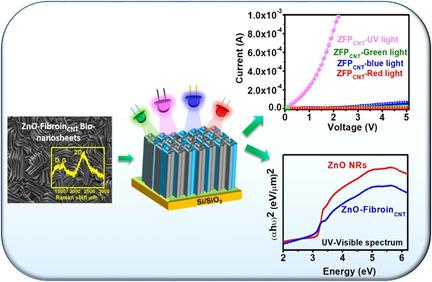当前位置:
X-MOL 学术
›
Chem. Eur. J.
›
论文详情
Our official English website, www.x-mol.net, welcomes your feedback! (Note: you will need to create a separate account there.)
Bio‐industrial Waste Silk Fibroin Protein and Carbon Nanotube‐Induced Carbonized Growth of One‐Dimensional ZnO‐based Bio‐nanosheets and their Enhanced Optoelectronic Properties
Chemistry - A European Journal ( IF 4.3 ) Pub Date : 2018-07-19 , DOI: 10.1002/chem.201800702 Adhimoorthy Saravanan,Bohr-Ran Huang,Deepa Kathiravan
Chemistry - A European Journal ( IF 4.3 ) Pub Date : 2018-07-19 , DOI: 10.1002/chem.201800702 Adhimoorthy Saravanan,Bohr-Ran Huang,Deepa Kathiravan

|
High performance UV/Visible photodetectors are successfully fabricated from ZnO/fibroin protein‐carbon nanotube (ZFPCNT) composites using a simple hydrothermal method. The as‐fabricated ZnO nanorods (ZnO NRs) and ZFPCNT nanostructures were measured under different light illuminations. The measurements showed the UV‐light photoresponse of the as‐fabricated ZFPCNT nanostructures (55,555) to be approximately 26454 % higher than that of the as‐prepared ZnO NRs (210). This photodetector can sense photons with energies considerably smaller (2.75 eV) than the band gap of ZnO (3.22 eV). It was observed that the finest distribution of fibroin and CNT into 1D ZnO resulted in rapid electron transportation and hole recombination via carbon/nitrogen dopants from the ZFPCNT. Carbon dopants create new energy levels on the conduction band of the ZFPCNT, which reduces the barrier height to allow for charge carrier transportation under light illumination. Moreover, the nitrogen dopants increase the adsorptivity and amount of oxygen vacancies in the ZFPCNT so that it exhibits fast response/recovery times both in the dark and under light illumination. The selectivity of UV light among the other types of illumination can be ascribed to the deep‐level energy traps (ET) of the ZFPCNT. These significant features of ZFPCNT lead to the excellent optical properties and creation of new pathways for the production of low‐cost semiconductors and bio‐waste protein based UV/Visible photodetectors.
中文翻译:

生物工业废丝素蛋白和碳纳米管诱导的一维基于ZnO的生物纳米片的碳化生长及其增强的光电性能
ZnO /纤维蛋白蛋白碳纳米管(ZFP CNT)复合材料通过简单的水热方法成功制造了高性能的紫外/可见光探测器。制成的ZnO纳米棒(ZnO NRs)和ZFP CNT纳米结构是在不同的光照下测量的。测量结果表明,制成的ZFP CNT纳米结构(55,555)的紫外光响应比制成的ZnO NR(210)高约26454%。该光电探测器可以以比ZnO的带隙(3.22 eV)小得多的能量(2.75 eV)感测光子。观察到,纤维蛋白和碳纳米管在1D ZnO中的最佳分布导致快速电子传输和ZFP中碳/氮掺杂剂的空穴重组。CNT。碳掺杂剂会在ZFP CNT的导带上产生新的能级,从而降低势垒高度,从而允许在轻度光照下传输载流子。而且,氮掺杂剂增加了ZFP CNT中的吸附性和氧空位的数量,从而使其在黑暗和光照下均表现出快速的响应/恢复时间。UV光的其它类型的照明之间的选择性可以归因于深能级能量陷阱(E Ť的ZFP的)CNT。ZFP CNT的这些重要功能 导致优异的光学性能,并开辟了生产低成本半导体和基于生物废物蛋白的紫外/可见光探测器的新途径。
更新日期:2018-07-19
中文翻译:

生物工业废丝素蛋白和碳纳米管诱导的一维基于ZnO的生物纳米片的碳化生长及其增强的光电性能
ZnO /纤维蛋白蛋白碳纳米管(ZFP CNT)复合材料通过简单的水热方法成功制造了高性能的紫外/可见光探测器。制成的ZnO纳米棒(ZnO NRs)和ZFP CNT纳米结构是在不同的光照下测量的。测量结果表明,制成的ZFP CNT纳米结构(55,555)的紫外光响应比制成的ZnO NR(210)高约26454%。该光电探测器可以以比ZnO的带隙(3.22 eV)小得多的能量(2.75 eV)感测光子。观察到,纤维蛋白和碳纳米管在1D ZnO中的最佳分布导致快速电子传输和ZFP中碳/氮掺杂剂的空穴重组。CNT。碳掺杂剂会在ZFP CNT的导带上产生新的能级,从而降低势垒高度,从而允许在轻度光照下传输载流子。而且,氮掺杂剂增加了ZFP CNT中的吸附性和氧空位的数量,从而使其在黑暗和光照下均表现出快速的响应/恢复时间。UV光的其它类型的照明之间的选择性可以归因于深能级能量陷阱(E Ť的ZFP的)CNT。ZFP CNT的这些重要功能 导致优异的光学性能,并开辟了生产低成本半导体和基于生物废物蛋白的紫外/可见光探测器的新途径。



























 京公网安备 11010802027423号
京公网安备 11010802027423号